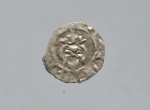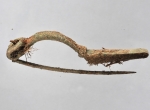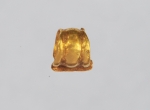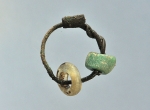The Hanging Cave at Kroczyce – the end of fieldwork season 2014
2014.11.19 -
The Hanging Cave at Kroczyce – the end of fieldwork season 2014
The second season of archaeological investigation of the Hanged Man Cave at Kroczyce ended on 31 August. This year’s research was carried out only inside the cave. Similarly as in the preceding season most of the effort went into removing the mass of sand and rock rubble, up to 1.50 m in thickness, left behind from extraction of calcite which supplied the glassworks at Zawiercie and from the activity of treasure hunters. Unfortunately, the worst case scenario from season 2013 was confirmed, namely that the stratigraphic sequence associated with the occupation of the cave during prehistory was almost fully destroyed by these pursuits - at least, in the central area of the main chamber. Only in a few spots the bottom level of the deposit had survived and rested over a layer of natural Pleistocene sand; its Neolithic age was established by the presence in it of flints associated with flint axe production. Careful exploration of the excavated deposit brought in a substantial quantity of finds: mostly, pottery and animal bone fragments, but also, flint flakes (mostly debitage), a clay spindlewhorl, and a gold suspension loop, presumably from a solidus-pendant probably belonging to the Migration Period deposit discovered recently.
The backbreaking work put into this year’s exploration inside the cave (credits to the terrific team of students from the University of Warsaw) has brought a long awaited breakthrough – the discovery of the remains of an undisturbed stratigraphic sequence by the north-western wall of the cave: two occupation levels datable to the Migration Period, and possibly, also to the Late Roman Period. They were divided by sealing layers, laid down presumably with the intention of making the cave interior more suitable for habitation (?) by forming a platform hemmed in with large blocks of stone on the edge of the cave. The younger occupation level was a layer of decayed wood overlain by a burnt spread – evidence, presumably, of a violent end to the occupation of the cave during the Migration Period. This is suggested by a modest group deposit discovered in the layers associated with this level – two bronze brooches buried in a small pit and fragments of a necklace: bronze pendants, glass and amber beads dropped less than a metre away. It is safe to interpret them as intentional deposits. As to the circumstances of their deposition, we hope to learn more by carbon dating some samples taken from the stratigraphy. If our assumptions regarding the chronology of the layers are confirmed we shall have gained a second (after Świlcza) dating of Migration Period samples for a Przeworsk Culture site. Given the total context of discoveries from the Hanging Cave we expect to see a significant progress in the study of the “troubled age” of interest on a macro scale.
According to the local lore the cave takes its name from the lynching of a Gestapo informer soon after the end of WW II.
MR
-
 full resolution
full resolution
-
 full resolution
full resolution
-
 full resolution
full resolution
-
 full resolution
full resolution
-
 full resolution
full resolution
-
 full resolution
full resolution
-
 full resolution
full resolution
-
 full resolution
full resolution
-
 full resolution
full resolution
-
 full resolution
full resolution
-
 full resolution
full resolution
-
 full resolution
full resolution
-
 full resolution
full resolution
-
 full resolution
full resolution
-
 full resolution
full resolution
-
 full resolution
full resolution
-
 full resolution
full resolution
-
 full resolution
full resolution
-
 full resolution
full resolution
-
 full resolution
full resolution
-
 full resolution
full resolution
-
 full resolution
full resolution
-
 full resolution
full resolution
-
 full resolution
full resolution
-
 full resolution
full resolution
-
 full resolution
full resolution


